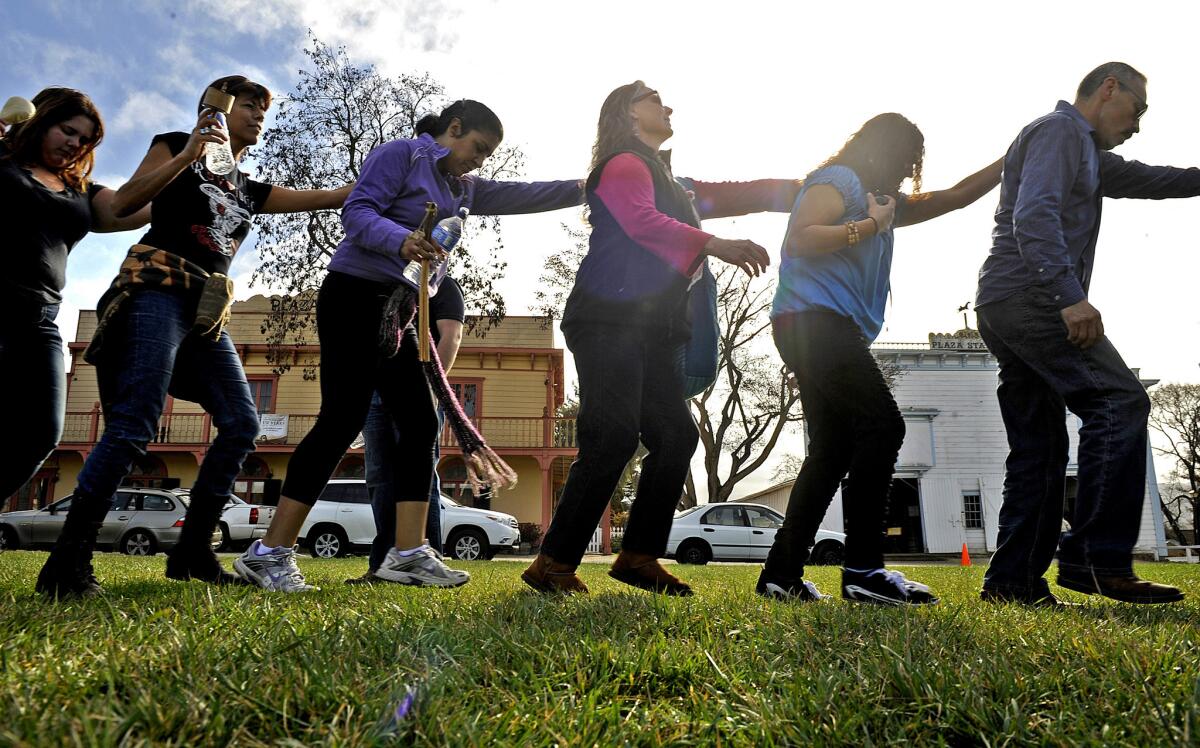Turning to Native rain dance in time of drought
In a weekly rain dance at Mission San Juan Bautista, Native Americans encourage everyone to join in a ceremony to break open the heavens and bring forth water.
SAN JUAN BAUTISTA, Calif. â The woman in line at the bank said she had already sold all her cattle and was now selling her land.
It was one too many tales of drought hardship for Laynee Reyna, also known as She Who Makes Things Happen â a name given to her by a shaman decades ago.
She felt a great spirit seize her. In the crowded bank lobby, the 79-year-old raised her arms.
"Everyone in this town has got to come together and pray and dance for rain, and we've got to do it now," she said.
Teresa Lavagnino, depositing checks at a teller's window, rushed over.
"Can you do it? Can you make that happen?" she asked. "I can spread the word."
The first San Juan Intertribal rain dance was held the next Sunday, two days after Gov. Jerry Brown declared a state drought emergency.
About 75 people, including the mayor and the local priest, formed a circle on the lawn of Old Mission San Bautista â quite a crowd in a city of 1,900.
"In a small town, when you call a rain dance, word gets around," said Ray Sanchez, a barbecue chef and construction worker of Apache heritage.
Reyna, silver-haired and yoga-slender, burned sage in an abalone shell. Sanchez and others beat drums. The circle danced clockwise, which Reyna said attracts low-pressure systems.
"We know it is our disrespect for Mother Earth that brings this drought. We humble ourselves. We call out for rain," she prayed.
It didn't rain that week. Reyna had never expected the heavens to open up immediately. But she wondered if the skies were clear because she hadn't led a true rain dance. She didn't know one. But she knew who did.

Kanyon Sayers-Roods, 25, grew up in lush Indian Canyon about 25 miles from San Juan Bautista.
During the Mission era, California Indians hid in this remote area when they escaped the priests and soldiers. Even now it's a hard place to find. Car navigation systems and cellphones don't work here, at the end of a long dirt road where the Ohlone/Costanoan people settled 4,200 years ago.
As a child, Sayers-Roods followed every deer trail, chased tree frogs and drank out of a year-round waterfall that never ran dry until this year.
Officially, the drought is in its third year. But she said she's been watching signs that something was wrong for more than a decade.
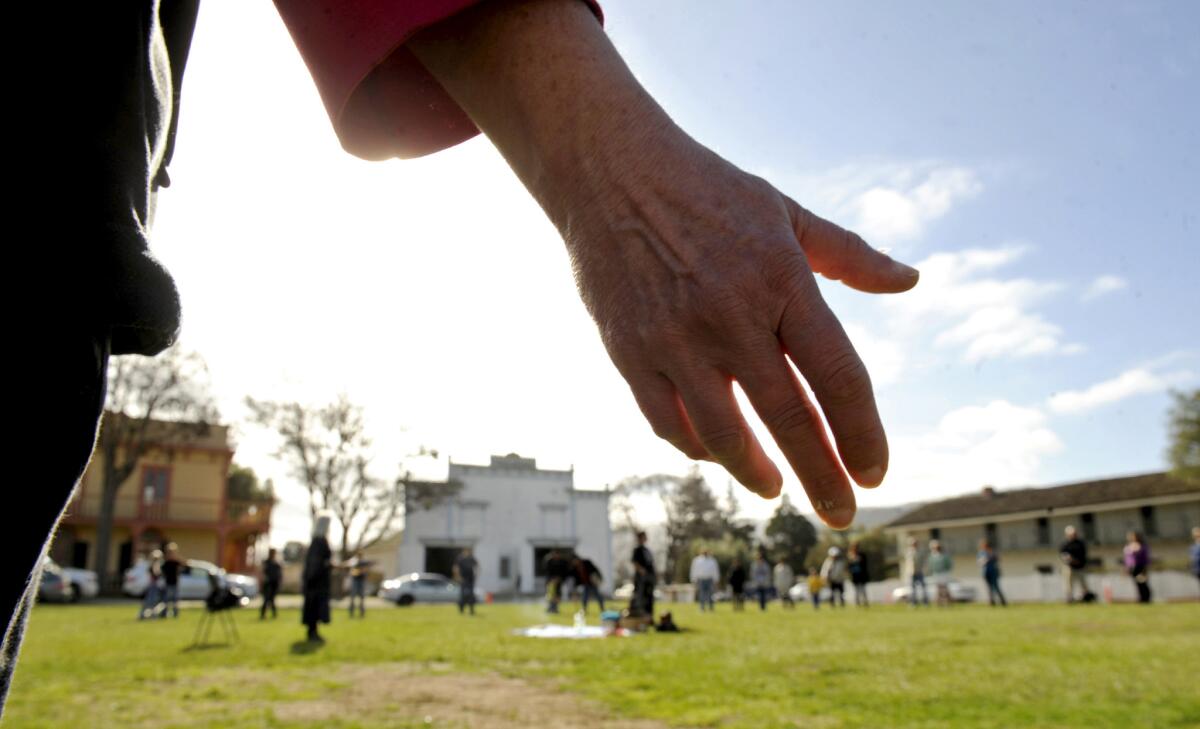
A participant prays in a circle during a rain dance in San Juan Bautista on a recent Sunday. One recent dance drew about 75 people. More photos
"The tree frogs disappeared, then the monarch butterflies," she said, pausing to pick a sprig of wild miner's lettuce (named for the men it saved from scurvy during the Gold Rush). She pointed to its pink stripes of dehydration.
Her mother, Ann-Marie Sayers, battled the federal government to claim her great-grandfather's land. Ten years ago, she led a yearlong project to record the stories of female Ohlone elders, many of whom had been taught to never publicly admit they were Indian. The older women said they remembered little of the culture, but sometimes they could recall parts of songs their grandmothers sang.
Sayers decided they should sew traditional regalia and dance and chant for the elders. Sayers-Roods put together steps and looked through a collection of words in the tribe's Mutson language.
"Mom, 'thunder' and 'rain' are the words calling to me," she told Sayers. "I hear a song that just came to me."
Their group rehearsed. It rained. It was June, past the rainy season.
They rehearsed three times. It drizzled three times.
"It was really interesting," Sayers said with a smile and a slight lift of an eyebrow.

In the last month, tribes from San Diego to Santa Barbara have held community rain dances. Midwestern tribes report being offered money to bring their sacred traditions to California. Buddhists hosted a dance in the Angeles National Forest. Wisdom Quarterly, an American Buddhist journal, listed tips for rain-calling ceremonies. ("Dance on a flat, level surface, never on a hill.")
Sayers, who has spent her life trying to reclaim her tribe's ancient traditions, isn't offended by the modern-day commotion.
"As to people's motivations, the answer is 'E' for everything," she said. "But in the moment when the dance begins, when the intent is pure, there is power in collective energy. My mother told me that when ceremony and dancing end, the world ends. I believe that."
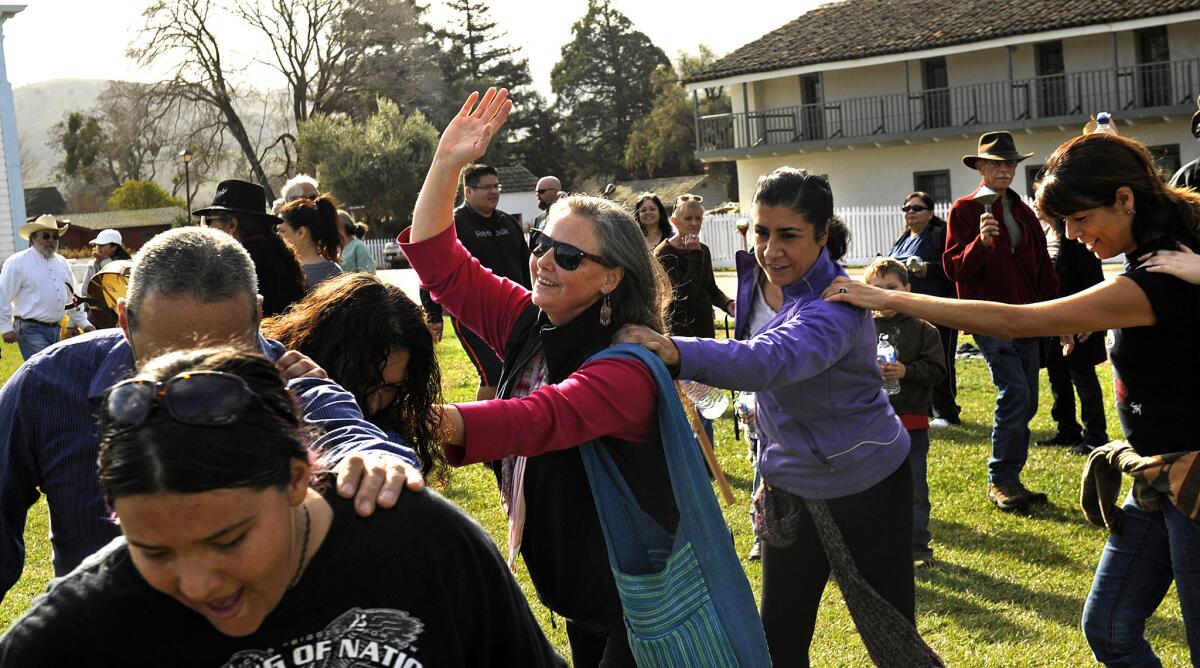
Participants dance in a circle during a rain dance in San Juan Bautista on a recent Sunday. The group meets every Sunday until the worst of the California drought ends. More photos
When word of a rain dance in San Juan Bautista started going around, there was an immediate reaction from people who wanted to take part.
"This thing kept making beeps and buzzes," Reyna said, holding out an offending phone.
She talked to Sonne Reyna, her ex-husband, who goes by the name Chief Sonne and owns a coffee shop in town.
The two were once hippies and both are still in the habit of flashing peace signs. Later, they were involved in the American Indian Movement, the group that led an armed standoff with federal agents at Wounded Knee, S.D., in 1973. Then they became interfaith ministers and held conferences in the giant tepee in their backyard.
They were married for 20 years. They marked their divorce on a hilltop, invited all their friends and considered it a sacred sign of approval when an eagle flew overhead. Now Chief Sonne lives in a trailer out by the tepee.
He loved the rain dance plan.
In a small town, when you call a rain dance, word gets around.ââ Ray Sanchez
"Magic has never left this place," he told the morning coffee crowd. "We're the ones who forgot. We should be aware and celebrate the magic of nature all the time. Use the power you were born with to dance and pray."
Reyna was certain the prayers of the group that turned out for the first gathering were sincere, but she still wanted a true rain dance.
When Sayers-Roods, a busy art school graduate, couldn't make it to town right away to teach Reyna the dance from 2004, Reyna learned the steps and words over a video phone call. That night, there were scattered showers.
The next morning, Feb. 2, the group danced in rain, the first measurable precipitation in more than six weeks.
Sanchez wore a long purple raincoat as he beat his drum alongside others. People felt their heartbeats match the pounding drums.
Reyna said she will dance at the mission every Sunday at 9:30 a.m., rain or shine, until the worst of the drought passes.

On a recent Sunday, a crowd gathered for their weekly rain dance in front of the 200-year-old mission, which had been built to convert the heathens.
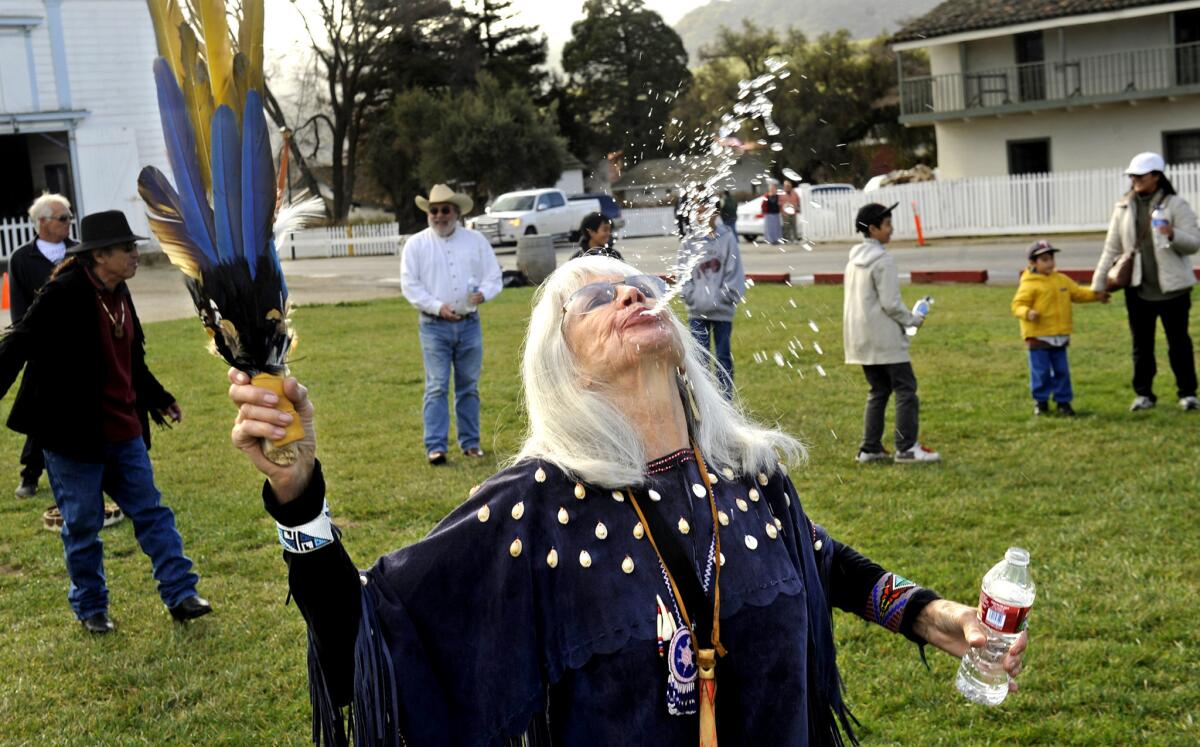
Laynee Reyna spits water during a rain dance in San Juan Bautista on a recent Sunday. ¿Water attracts water,¿ she said. More photos
"Destiny is a strange cat. History always has a sense of humor," Sonne Reyna said.
"We dance here because there's a lawn," Laynee Reyna said with a shrug.
As Mass let out, Sonne Reyna called out to the parishioners with his big traveling-minister grin.
"Come on over, we're praying for rain!" he shouted. "Join the circle. Take your place. We are all tribal people."
A few churchgoers joined a group that included women in running clothes, a girl in pink cowboy boots and the tattooed owner of a pool-cleaning company who had brought his Boston terrier, Penney.
Smoke from white sage wafted in coils across the lawn. The air smelled damp from showers the night before.
"We are they who are calling the rain," Laynee Reyna said from the center of the circle. "We are true to where we stand â on our Mother Earth."
Sayers-Roods, a native cloth tied sarong-style over jeans, told everyone to place a hand on the shoulder of the person in front of them.
The circle danced clockwise. And then counter-clockwise to make sure there wasn't too much rain and landslides.
Some women of an age who would favor Donna Summer added a disco touch. The children formed their own circle in the middle of the larger one.
Reyna passed out bottles of water. She told people to take a sip and spit it out as they danced. Spit it in the air. Spit it on the ground. "Water attracts water."
People were laughing. It turned into a spitting water fight. Penney the terrier did her part by licking children's faces.
"Have fun. It's OK," Sayers-Roods told them. "This is a serious matter. But without laughter you cannot be serious."
In a remarkably clear voice, she sang the song that came to her in the language of her ancestors.
Mak-et tcite. We dance for you.
Amani auye tura. Rain awaken thunder.
The circle chanted: Amani, amani, amani. Rain, rain, rain.
Follow Diana Marcum(@DianaMarcum) on Twitter
Follow @latgreatreads on Twitter
More great reads
Square dancing to heal the heart in Riverside
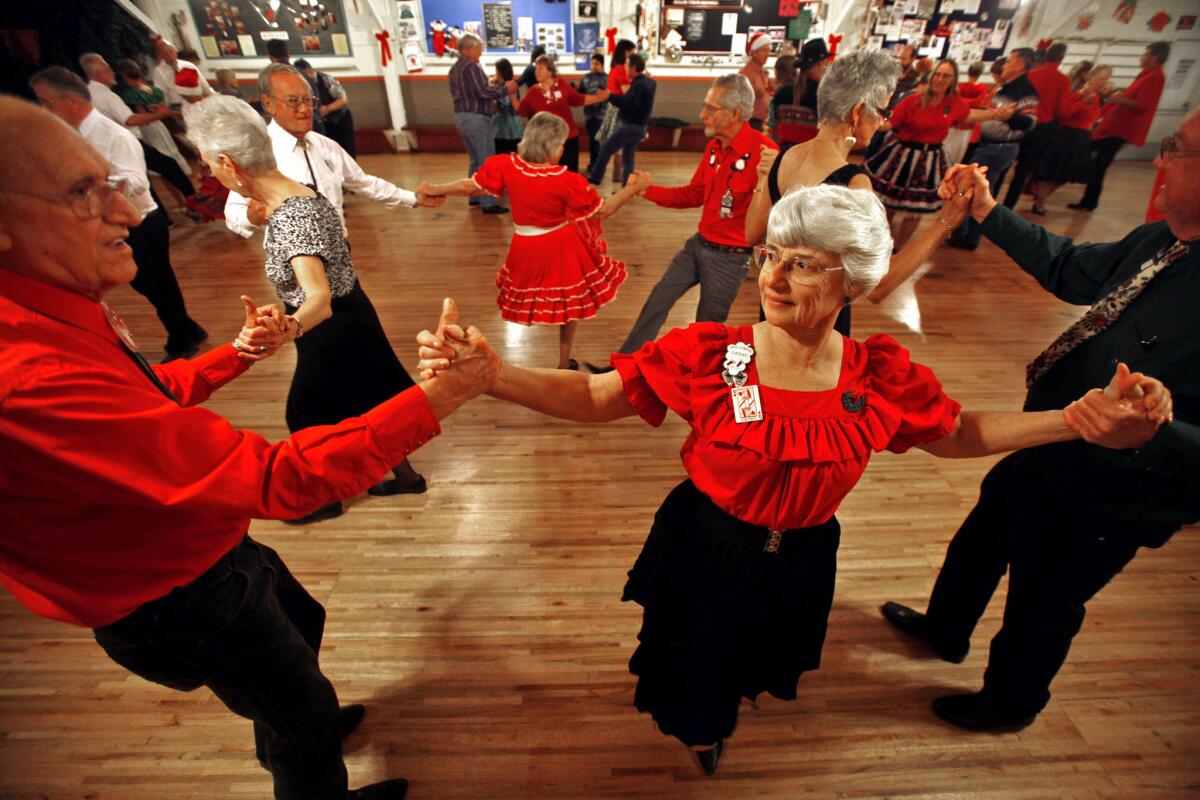
He walked across the floor...and I said, 'He's my next victim!'â
Camaraderie, goofy moves fire up dance troupe
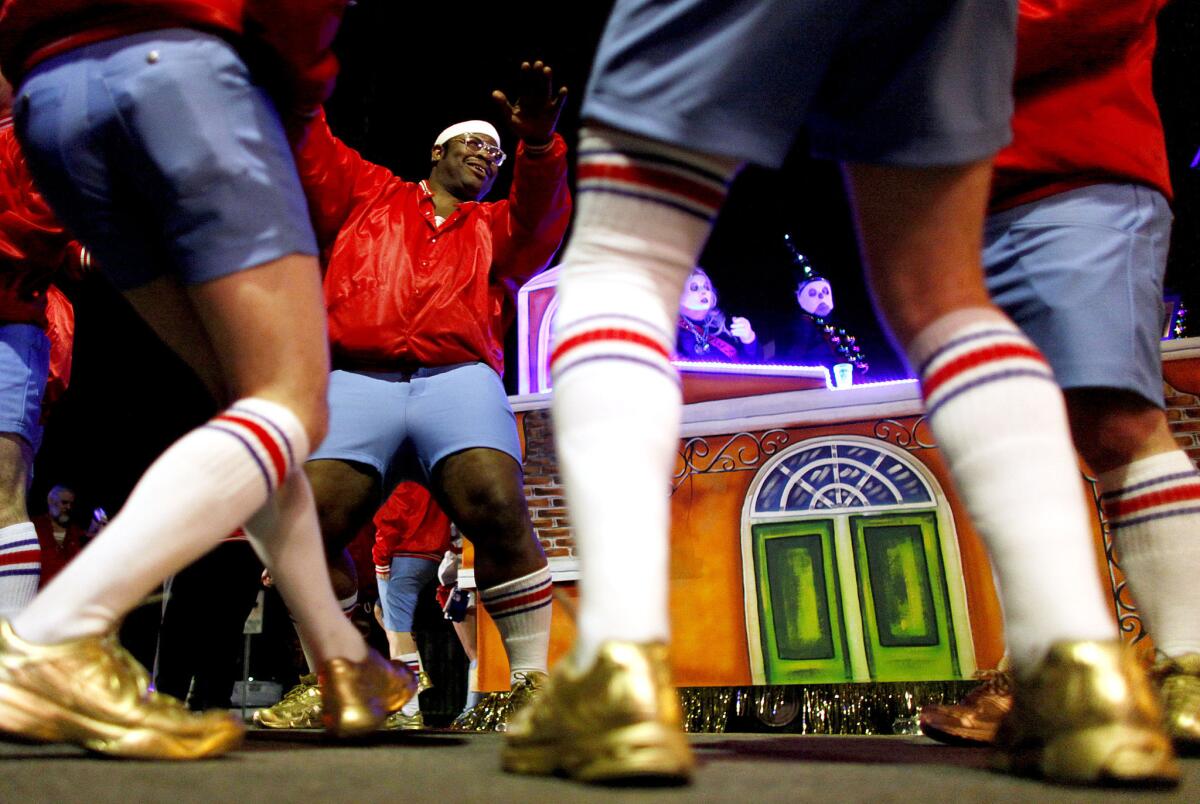
Our dances are as far from professional as you can imagine.â
Sign up for Essential California
The most important California stories and recommendations in your inbox every morning.
You may occasionally receive promotional content from the Los Angeles Times.
